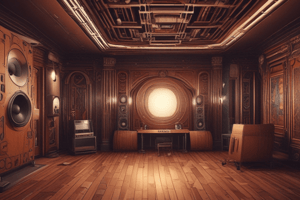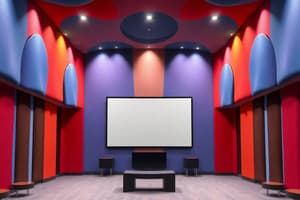Podcast
Questions and Answers
What is the main factor that influences the loudness of reflected sound in a room?
What is the main factor that influences the loudness of reflected sound in a room?
Room absorption
What term is used to describe the prolongation of sound caused by waves ricocheting between room surfaces?
What term is used to describe the prolongation of sound caused by waves ricocheting between room surfaces?
Reverberation
How is reverberation time defined?
How is reverberation time defined?
The time measured in seconds a sound average loudness can be heard before it becomes inaudible under quiet conditions.
At what point does speech become unintelligible due to excessive reverberation time?
At what point does speech become unintelligible due to excessive reverberation time?
What is the ideal reverberation time for classrooms or lecture spaces?
What is the ideal reverberation time for classrooms or lecture spaces?
What is the recommended reverberation time for orchestral, choral, and church music?
What is the recommended reverberation time for orchestral, choral, and church music?
How does the reflection of sound waves affect acoustics?
How does the reflection of sound waves affect acoustics?
What determines the loudness of direct sound waves to a listener?
What determines the loudness of direct sound waves to a listener?
Why is the loudness of reflected sound always less than direct sound?
Why is the loudness of reflected sound always less than direct sound?
What are the two effects of multiple reflections of sound waves on acoustics?
What are the two effects of multiple reflections of sound waves on acoustics?
What is the result of combining direct sound and reflected sound in terms of loudness?
What is the result of combining direct sound and reflected sound in terms of loudness?
How does the direction of travel of a sound wave change when it strikes a surface?
How does the direction of travel of a sound wave change when it strikes a surface?
What is the interval needed for an echo to be easily distinguished in a room with low reverberation time?
What is the interval needed for an echo to be easily distinguished in a room with low reverberation time?
Which type of surfaces can produce very annoying echoes due to their focusing action?
Which type of surfaces can produce very annoying echoes due to their focusing action?
What percentage of sounds do hard, reflective, nonporous interior building surfaces absorb?
What percentage of sounds do hard, reflective, nonporous interior building surfaces absorb?
What is a perfect sound absorber?
What is a perfect sound absorber?
What unit of sound absorption is equivalent to one square foot having a coefficient of absorption of 1.00?
What unit of sound absorption is equivalent to one square foot having a coefficient of absorption of 1.00?
How many sabins will a concrete floor of 10,000 square feet, with an absorption coefficient of 0.015 at 500 Hz, yield?
How many sabins will a concrete floor of 10,000 square feet, with an absorption coefficient of 0.015 at 500 Hz, yield?
Flashcards are hidden until you start studying




